
Texas Border Business
LEA, THOMAS CALLOWAY III (1907-2001) Tom Lea was an artist and writer who excelled as a muralist, illustrator, portraitist, landscapist, World War II artist correspondent, poet, novelist and historian. Born in El Paso, Texas, on July 11, 1907, he was the eldest of three boys of Zola (Utt) Lea and Thomas Calloway Lea, Jr. His mother made sure that he attended the Baptist church and knew the Bible. His father was a populist lawyer who became El Paso’s mayor from 1915 to 1917 during the Mexican Revolution. The bedtime stories Mayor Lea told his sons about Daniel Boone and Davy Crockett were matched by real-life adventures of watching battles on the other side of the Rio Grande in Ciudad Juárez through a telescope and being escorted to elementary school by a policeman after Pancho Villa threatened the Lea family.
Mount Franklin, which stood outside Tom Lea’s boyhood home, remained a familiar presence his entire life. His childhood was happy with parents who supported his desire to be an artist—his father quipped that he’d rather his son be a “good blacksmith” than a “poor preacher.” El Paso’s librarian introduced Lea to art books, his high school art teacher suggested he design the El Paso High School annual, and his English teachers provided the foundation for his becoming a writer. During high school summers Tom Lea traveled to Santa Fe to stay with a federal judge and friend of his father’s. He visited his first museum there and became familiar with Indian cultures. He also met landscape painter Fremont Ellis, the first artist to take his work seriously.
In 1924 Tom Lea graduated from El Paso High School and left for the Art Institute of Chicago where he studied under muralist John Warner Norton and became a paid apprentice on murals in Chicago and other cities. He married fellow art student Nancy Jane Taylor, an aspiring writer, in 1927. Tom and Nancy Lea befriended a couple living in Kenilworth, Illinois, who opened their library and introduced them to books by Ernest Hemingway, Gertrude Stein, F. Scott Fitzgerald, and Aldous Huxley. Lea also worked as a freelance commercial artist doing advertisements and appearing in the Saturday Evening Post. In 1930 he had earned enough money to take Nancy to Europe, where they explored Italian Renaissance murals and other great artistic achievements.
In 1933 Tom and Nancy Lea moved to Santa Fe, New Mexico, where he worked for the Laboratory of Anthropology and painted for the Works Progress Administration (WPA, see WORK PROJECTS ADMINISTRATION). He completed paintings for the Museum of Fine Arts in Santa Fe and murals for the library at New Mexico College of Agriculture and Mechanic Arts (now New Mexico State University). Soon after moving into their one-room adobe home on Fremont Ellis’s Rancho San Sebastian, Nancy suffered an appendicitis attack. After a botched operation in the Santa Fe hospital, infection set in from which Nancy never recovered. She died in El Paso on April 1, 1936. After driving to Santa Fe to recover a few things, Tom Lea left and never returned again.
Work kept Lea going in 1936 when his mother and grandmother’s deaths left him bereft of the most important women in his life. During that time mural painters benefitted from federal government projects through the Treasury Department, Section of Fine Arts. He won the competition for the Ben Franklin Post Office on Pennsylvania Avenue in Washington, D.C., in 1936 with his mural The Nesters, which brought him national attention and led to his selection for the Texas Centennial murals in the Hall of State at Fair Park in Dallas. Of the sixteen murals Tom Lea painted, seven were done for the federal government with the majority painted between 1934 and 1941.
While working on the Pass of the North mural in the El Paso federal courthouse in 1938, he met Sarah Catherine Dighton Beane, a divorcée from Monticello, Illinois, who had come to El Paso to visit a friend. He proposed on the first date, and they were married in July. The union lasted sixty-three years. Sarah’s son, James, from her previous marriage, was adopted by Lea. Tom Lea later said that his portrait of Sarah in the Summertime, which he painted after his return from World War II in 1947, was his favorite painting and the best work he ever did.
Carl Hertzog and J. Frank Dobie were two friends of great import to Tom Lea’s work. Hertzog, a printer and book designer, and Dobie, a writer, sharpened Lea’s attention to the writing and making of books. He illustrated Dobie’s Apache Gold and Yaqui Silver (1939), John C. Duval: First Texas Man of Letters (1939), and The Longhorns (1941), giving him national visibility and bringing him to the attention to the managing editor of Life magazine who read Dobie’s books.
After being awarded a fellowship from the Rosenwald Foundation in 1940 to paint a series of paintings about authentic Southwest figures in authentic Southwest landscapes, Tom Lea received a telegraphed invitation from Life magazine to board a United States Navy destroyer in the North Atlantic as an accredited war artist correspondent. He resigned his fellowship and for four years traveled more than 100,000 miles and documented U.S. and Allied soldiers, sailors, and airmen worldwide. In the North Atlantic he covered the fight against German U-boats in late 1941; he was aboard the carrier USS Hornet during the air and sea battles off Guadalcanal in 1942 and witnessed the sinking of the USS Wasp; he traveled halfway around the world with the United States Army Air Forces transport, fighter, and bomber crews in England, North Africa, and China in 1943; and he landed on Peleliu with the Seventh Marine Regiment of the First Marine Division in 1944. His paintings and writing were featured in ten issues of Life magazine between 1941 and 1945. During the war he also painted a number of notable portraits, including Claire Chennault, Jimmy Doolittle, and Chinese Nationalist leader Chiang Kai-shek and his wife.
Upon returning from war, Tom Lea turned to writing and realized “there are many parts of mankind’s living and dying better expressed with words than with paint.” He wrote The Brave Bulls (1949) about bullfighting in Mexico, a bestseller published in ten foreign editions and turned into a motion picture starring Mel Ferrer. Lea’s The Wonderful Country (1952) about pistol-toting in Chihuahua became a bestseller published in three foreign editions and was made into a film starring Robert Mitchum. His two-volume history The King Ranch (1957) was considered by some scholars to be the greatest ranching history ever written. Lea wrote The Primal Yoke (1960) about mountaineering in Wyoming; The Hands of Cantú (1964) about horse training in sixteenth-century Nueva Viscaya; A Picture Gallery (1968), an autobiographical work about the experiences documented in his paintings; and In the Crucible of the Sun (1974) about King Ranch properties in Australia. He illustrated all of his books in pen and ink, Chinese ink wash, watercolor, or oil on canvas. The majority of his books were published by Little Brown and Company of Boston. The Brave Bulls won the Carr P. Collins Award from the Texas Institute of Letters and The Hands of Cantú won the Texas Institute’s Jesse Jones Award.
During the last decades of his life, Lea’s interest in writing books diminished, and he felt a renewed interest in painting. He and Sarah traveled far and wide, and he painted places as remote as China, Equador, Somoa, and Australia—though most of his subjects were from the vicinities of home. Lea painted portraits, but never for hire; he reserved them for his own pleasure and for friends who could pose in his studio. Only twice did he make exceptions—he once painted a portrait of Sam Rayburn for the Rayburn Building in Washington, D.C. (1966), and he painted Benito Juarez, now in the collection of the U. S. State Department in Washington, D.C. (1948).
Describing himself as an “avowed painter of the Almighty’s own outward and visible handiwork,” Tom Lea’s favorite subjects were the Southwestern landscape he knew so well with authentic Southwestern figures. He wrote that each of his subjects had “its own worthiness, each awaiting summons—upon right occasion—for portrait likeness.” He received numerous honors during his life, including the first Lon Tinkle Award for Lifetime Achievement from the Texas Institute of Letters in 1981. In 1995 the Marine Corps Heritage Foundation presented Lea the Colonel John W. Thomason, Jr. Award for his depictions of Marines during World War II. The El Paso Museum of Art established its Tom Lea Gallery in 1996, and in 1997 he was honored as a Fellow in the Texas State Historical Association.
In accepting the Republican nomination for president in 2000, George W. Bush quoted Tom Lea’s optimistic words about living on the sunrise side of Mount Franklin (quoted from his book A Picture Gallery). “Sarah and I live on the east side of our mountain. It is the sunrise side, not the sunset side. It is the side to see the day that is coming, not the side to see the day that is gone. The best day is the day coming, with the work to do, with the eyes wide open, with the heart grateful.” For eight years, Tom Lea’s painting Rio Grande, on loan from the El Paso Museum of Art, was displayed in the Oval Office of the White House.
On January 29, 2001, Tom Lea died at Sierra Medical Center in El Paso from injuries suffered from a fall. His family was by his side, and the familiar site of Mount Franklin was visible outside his hospital window. Hundreds of people attended his memorial service at First Baptist Church, including First Lady Laura Bush. On May 14, 2005, a commemorative cenotaph was erected for Lea and his wife in the Texas State Cemetery. After Sarah Lea died in 2008, their ashes were scattered over Mount Franklin. His extensive collections of art, papers, and photography are housed in the Harry Ransom Center on the campus of the University of Texas at Austin as well as the Special Collections of the University of Texas at El Paso. His paintings done for Life magazine during World War II are held by the U. S. Army Center of Military History, Fort Belvoir, Virginia. The Tom Lea Institute in El Paso was established to preserve the artist’s legacy. Pulitzer-winning biographer Robert Caro called him “an unsung genius of the twentieth century who made it purely on the quality of his work.” Texas collector and historian J. P. Bryan wrote, “Tom Lea was the greatest artist, illustrator and writer Texas has ever known.”
Biography by Adair Margo, Handbook of Texas Online
Published by the Texas State Historical Association















